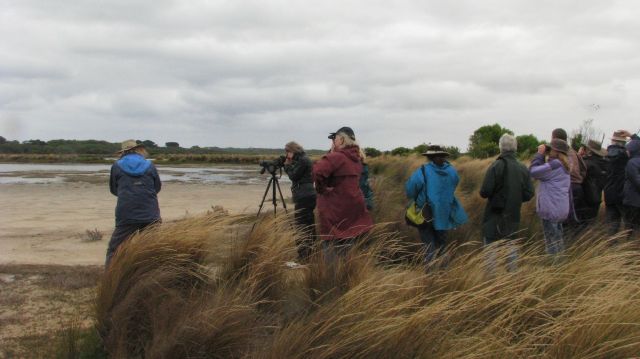The January walk was organised especially to use, for the first time on a bird walk, Angair’s great new spotting scope. A total of 54 species were identified.
(The first actual use was watching the four moons of Jupiter at the November Grampians camp.)

The new telescope
We fortunately ended up with three other telescopes, as all four were in constant use by the 17 people who came.

Four are better than one
Lake Victoria had swarms of birds, such as over 500 Grey Teal.

So many birds to see
However the migratory waders were our main focus and there were flocks of them, especially Red-necked Stints, wheeling and landing near us.

We only had to walk about 100 metres to be offered this stunning view of water birds.
A special sighting was two Great Crested Grebes and several Red-kneed Dotterels, which I have rarely seen in our area.
Once we were fully sated we moved on to Lake Lorne for late morning tea or early lunch. We were able to sit just in front of our cars for another wonderful view of water birds, but no waders.

Time for food and coffee, but keep the binos handy!
A special sighting here was five of the rare Freckled Duck, resting on logs at one end of the island.

No need to walk far
At the end of the excursion, a few of us gained some minimal exercise walking around the lake for a closer view of the birds. We identified a few new species such as a Little Grassbird, initially by its unusual, penetrating, mournful call. A wonderful day!

How about the bush birds?
Below are all the birds identified on this walk:
1. Musk duck
2. Freckled Duck
3. Black Swan
4. Australian Wood Duck
5. Grey Teal
6. Chestnut Teal
7. Pacific Black Duck
8. Hardhead
9. Blue-billed Duck
10. Australasian Grebe
11. Hoary-headed Grebe
12. Great Crested Grebe
13. Little Pied Cormorant
14. Little Black Cormorant
15. Australian Pelican
16. Eastern Great Egret
17. White-faced Heron
18. Little Egret
19. Australian White Ibis
20. Straw-necked Ibis
21. Royal Spoonbill
22. Whistling Kite
23. Nankeen Kestrel
24. Purple Swamphen
25. Dusky Moorhen
26. Eurasian Coot
27. Black-winged Stilt
28. Red-necked Avocet
29. Red-capped Plover
30. Black-fronted Dotterel
31. Red-kneed Dotterel
32. Masked Lapwing
33. Common Greenshank
34. Red-necked Stint
35. Sharp-tailed Sandpiper
36. Curlew Sandpiper
37. Whiskered Tern
38. Silver Gull
39. Eastern Rosella
40. Superb Fairy-wren
41. Striated Fieldwren
42. White-plumed Honeyeater
43. Noisy Miner
44. White-fronted Chat
45. New Holland Honeyeater
46. Grey Butcherbird
47. Australian Magpie
48. Grey Fantail
49. Willy Wagtail
50. Little Raven
51. Magpie-lark
52. Little Grassbird
53. Welcome Swallow
54. Common Starling
The Saturday after this walk I went wader-counting with the Geelong Field Naturalists at Lake Connewarre on the way to Point Lonsdale. The abundant birdlife there was a joy to see. Once again there were flocks of waders, but this time mainly Sharp-tailed Sandpipers…over 500. I also got my fill of Red-kneed Dotterels, with over 130 seen by my group. However I fear for all the beautiful ducks, which will be legitimate prey in the upcoming duck-shooting season.
Ellinor Campbell